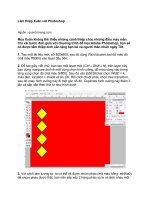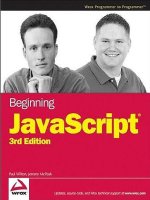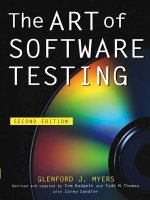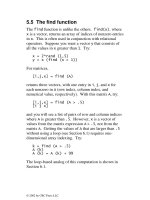matlab primer 7th edition phần 1 pdf
Bạn đang xem bản rút gọn của tài liệu. Xem và tải ngay bản đầy đủ của tài liệu tại đây (261.86 KB, 23 trang )
www.dbeBooks.com - An Ebook Library
MATLAB
®
Primer
Seventh Edition
CHAPMAN & HALL/CRC
A CRC Press Company
Boca Raton London New York Washington, D.C.
MATLAB
®
Primer
Seventh Edition
Timothy A. Davis
Kermit Sigmon
This book contains information obtained from authentic and highly regarded
sources. Reprinted material is quoted with permission, and sources are indi-
cated. A wide variety of references are listed. Reasonable efforts have been
made to publish reliable data and information, but the author and the publisher
cannot assume responsibility for the validity of all materials or for the con-
sequences of their use.
Neither this book nor any part may be reproduced or transmitted in any form
or by any means, electronic or mechanical, including photocopying, micro-
filming, and recording, or by any information storage or retrieval system,
without prior permission in writing from the publisher.
The consent of CRC Press does not extend to copying for general distribution,
for promotion, for creating new works, or for resale. Specific permission must
be obtained in writing from CRC Press for such copying.
Direct all inquiries to CRC Press, 2000 N.W. Corporate Blvd., Boca Raton,
Florida 33431.
Trademark Notice:
Product or corporate names may be trademarks or reg-
istered trademarks, and are used only for identification and explanation,
without intent to infringe.
Visit the CRC Press Web site at www.crcpress.com
© 2005 by Chapman & Hall/CRC
No claim to original U.S. Government works
International Standard Book Number 1-58488-523-8
Printed in the United States of America 1 2 3 4 5 6 7 8 9 0
Printed on acid-free paper
Library of Congress Cataloging-in-Publication Data
Catalog record is available from the Library of Congress
C5238 disclaimer.fm Page 1 Friday, November 12, 2004 1:31 PM
iii
Preface
Kermit Sigmon, author of the MATLAB® Primer, passed
away in January 1997. Kermit was a friend, colleague,
and fellow avid bicyclist (although I’m a mere 10-mile-a-
day commuter) with whom I shared an appreciation for
the contribution that MATLAB has made to the
mathematics, engineering, and scientific community.
MATLAB is a powerful tool, and my hope is that in
revising our book for MATLAB 7.0, you will be able to
learn how to apply it to solving your own challenging
problems in mathematics, science, and engineering.
A team at The MathWorks, Inc. revised the Fifth Edition
for MATLAB Version 5 in November of 1997. I carried
on Kermit’s work by creating the Sixth Edition of this
book for MATLAB 6.1 in October 2001, and now this
Seventh Edition for MATLAB Version 7.0.
This edition highlights the many new features of
MATLAB 7.0, and includes new chapters on features that
were in prior versions of MATLAB but not in prior
editions of this book. New or revised topics in this
edition include:
• calling Java from MATLAB, and using Java objects
inside the MATLAB workspace
• many more graphics examples, including the seashell
on the cover of the book
• cell publishing for reports in HTML, LaTeX,
Microsoft Word, and Microsoft Powerpoint
• powerful suite of code development tools (such as the
M-Lint code checker, the file dependency and
comparison reports, and a profile coverage report)
iv
• volume and vector visualization
• calling Fortran code from MATLAB
• parametric curves and surfaces, and polar plots of
symbolic functions
• polynomials, interpolation, and numeric integration
• solving non-linear equations with
fzero
• solving ordinary differential equations with
ode45
• the revised MATLAB Desktop
• short-circuit logical operators
• integers and single precision floating-point
• more details on the colon operator
•
linsolve, for solving specific linear systems
• the new block comment syntax
• function handles (
@), which are now simpler to use
• anonymous functions
•
image, and a pretty Mandelbrot set example
• the new 4-output sparse
lu
• abstract symbolic functions
• nicely-formatted tables using
fprintf
• a revised list of all primary functions and operators in
MATLAB.
I would like to thank Penny Anderson at The MathWorks,
Inc. for her detailed review of this book.
Tim Davis
Associate Professor, Department of Computer and
Information Science and Engineering, University of
Florida,
v
Introduction
MATLAB®, developed by The MathWorks, Inc.,
integrates computation, visualization, and programming
in a flexible, open environment. It offers engineers,
scientists, and mathematicians an intuitive language for
expressing problems and their solutions mathematically
and graphically. Complex numeric and symbolic
problems can be solved in a fraction of the time required
with a programming language such as C, Fortran, or Java.
How to use this book: The purpose of this Primer is to
help you begin to use MATLAB. It is not intended to be
a substitute for the online help facility or the MATLAB
documentation (such as Getting Started with MATLAB,
available in printed form and online). The Primer can
best be used hands-on. You are encouraged to work at
the computer as you read the Primer and freely
experiment with the examples. This Primer, along with
the online help facility, usually suffices for students in a
class requiring the use of MATLAB.
Start with the examples at the beginning of each chapter.
In this way, you will create all of the matrices and M-files
used in the examples. Some examples depend on code
you write in previous chapters.
Larger examples (M-files and MEX-files) are on the web
at and
.
Pull-down menu selections are described using the
following style. Selecting the
Desktop menu, and then
the
Desktop Layout submenu, and then the Default
vi
menu item is written as Desktop ► Desktop Layout ►
Default.
You should liberally use the online help facility for more
detailed information. Pressing the F1 key or selecting
Help ► MATLAB Help brings up the Help window. You
can also type
help or doc in the Command window. See
Sections 2.1 or 22.26 for more information on how to use
the online help.
How to obtain MATLAB: Version 7.0 (Release 14) of
MATLAB is available for Microsoft Windows (XP, 2000,
and NT 4.0), Unix (Linux, Solaris 2.8 and 2.9, and HP-
UX 11 or 11i), and the Macintosh (OS X 10.3.2 Panther).
A Student Version is available for all but Solaris and HP-
UX; it includes MATLAB, Simulink, and key functions
of the Symbolic Math Toolbox. Everything discussed in
this book can be done in the Student Version of
MATLAB, with the exception of advanced features of the
Symbolic Math Toolbox discussed in Section 16.13.
MATLAB, Simulink, Handle Graphics, StateFlow, and
Real-Time Workshop are registered trademarks of The
MathWorks, Inc. TargetBox is a trademark of The
MathWorks, Inc. For more information on MATLAB,
contact:
The MathWorks, Inc.
3 Apple Hill Drive
Natick, MA, 01760-2098 USA
Phone: 508–647–7000
Fax: 508–647–7101
Web:
vii
Table of Contents
1. Accessing MATLAB 1
2. The MATLAB Desktop 1
2.1 Help window 2
2.2 Start button 3
2.3 Command window 3
2.4 Workspace window 7
2.5 Command History window 8
2.6 Array Editor window 9
2.7 Current Directory window 9
3. Matrices and Matrix Operations 10
3.1 Referencing individual entries 10
3.2 Matrix operators 11
3.3 Matrix division (slash and backslash) 12
3.4 Entry-wise operators 13
3.5 Relational operators 13
3.6 Complex numbers 15
3.7 Strings 16
3.8 Other data types 16
4. Submatrices and Colon Notation 18
4.1 Generating vectors 18
4.2 Accessing submatrices 19
5. MATLAB Functions 21
5.1 Constructing matrices 21
5.2 Scalar functions 23
5.3 Vector functions and data analysis 23
5.4 Matrix functions 24
5.5 The linsolve function 25
5.6 The find function 27
6. Control Flow Statements 29
6.1 The for loop 29
viii
6.2 The while loop 31
6.3 The if statement 32
6.4 The switch statement 33
6.5 The try/catch statement 33
6.6 Matrix expressions (if and while) 33
6.7 Infinite loops 35
7. M-files 35
7.1 M-file Editor/Debugger window 35
7.2 Script files 36
7.3 Function files 40
7.4 Multiple inputs and outputs 41
7.5 Variable arguments 42
7.6 Comments and documentation 42
7.7 MATLAB’s path 43
8. Advanced M-file Features 43
8.1 Function handles and anonymous functions 43
8.2 Name resolution 47
8.3 Error and warning messages 48
8.4 User input 49
8.5 Performance measures 49
8.6 Efficient code 51
9. Calling C from MATLAB 53
9.1 A simple example 54
9.2 C versus MATLAB arrays 55
9.3 A matrix computation in C 55
9.4 MATLAB mx and mex routines 59
9.5 Online help for MEX routines 60
9.6 Larger examples on the web 60
10. Calling Fortran from MATLAB 61
10.1 Solving a transposed system 61
10.2 A Fortran mexFunction with %val 62
10.3 If you cannot use %val 64
11. Calling Java from MATLAB 65
11.1 A simple example 65
ix
11.2 Encryption/decryption 65
11.3 MATLAB’s Java class path 67
11.4 Calling your own Java methods 67
11.5 Loading a URL as a matrix 69
12. Two-Dimensional Graphics 70
12.1 Planar plots 71
12.2 Multiple figures 72
12.3 Graph of a function 72
12.4 Parametrically defined curves 73
12.5 Titles, labels, text in a graph 73
12.6 Control of axes and scaling 74
12.7 Multiple plots 75
12.8 Line types, marker types, colors 76
12.9 Subplots and specialized plots 77
12.10 Graphics hard copy 77
13. Three-Dimensional Graphics 78
13.1 Curve plots 78
13.2 Mesh and surface plots 79
13.3 Parametrically defined surfaces 80
13.4 Volume and vector visualization 81
13.5 Color shading and color profile 81
13.6 Perspective of view 82
14. Advanced Graphics 83
14.1 Handle Graphics 83
14.2 Graphical user interface 84
14.3 Images 84
15. Sparse Matrix Computations 85
15.1 Storage modes 85
15.2 Generating sparse matrices 86
15.3 Computation with sparse matrices 89
15.4 Ordering methods 89
15.5 Visualizing matrices 91
16. The Symbolic Math Toolbox 91
16.1 Symbolic variables 92
x
16.2 Calculus 93
16.3 Variable precision arithmetic 99
16.4 Numeric and symbolic subsitution 100
16.5 Algebraic simplification 102
16.6 Two-dimensional graphs 103
16.7 Three-dimensional surface graphs 105
16.8 Three-dimensional curves 107
16.9 Symbolic matrix operations 108
16.10 Symbolic linear algebraic functions 110
16.11 Solving algebraic equations 113
16.12 Solving differential equations 116
16.13 Further Maple access 117
17. Polynomials, Interpolation, and
Integration 118
17.1 Representing polynomials 118
17.2 Evaluating polynomials 119
17.3 Polynomial interpolation 119
17.4 Numeric integration (quadrature) 121
18. Solving Equations 122
18.1 Symbolic equations 122
18.2 Linear systems of equations 122
18.3 Polynomial roots 123
18.4 Nonlinear equations 123
18.5 Ordinary differential equations 125
18.6 Other differential equations 127
19. Displaying Results 128
20. Cell Publishing 132
21. Code Development Tools 133
21.1 M-lint code check report 134
21.2 TODO/FIXME report 135
21.3 Help report 135
21.4 Contents report 137
21.5 Dependency report 138
21.6 File comparison report 139
xi
21.7 Profile and coverage report 139
22. Help Topics 141
22.1 General purpose commands 143
22.2 Operators and special characters 146
22.3 Programming language constructs 148
22.4 Elementary matrices and matrix manipulation 150
22.5 Elementary math functions 152
22.6 Specialized math functions 154
22.7 Matrix functions — numerical linear algebra . 156
22.8 Data analysis, Fourier transforms 158
22.9 Interpolation and polynomials 159
22.10 Function functions and ODEs 161
22.11 Sparse matrices 163
22.12 Annotation and plot editting 165
22.13 Two-dimensional graphs 165
22.14 Three-dimensional graphs 166
22.15 Specialized graphs 169
22.16 Handle Graphics 172
22.17 Graphical user interface tools 174
22.18 Character strings 177
22.19 Image and scientific data 179
22.20 File input/output 180
22.21 Audio and video support 183
22.22 Time and dates 184
22.23 Data types and structures 184
22.24 Version control 188
22.25 Creating and debugging code 188
22.26 Help commands 189
22.27 Microsoft Windows functions 190
22.28 Examples and demonstrations 191
22.29 Preferences 191
22.30 Symbolic Math Toolbox 192
xii
23. Additional Resources 198
Index 202
1
1. Accessing MATLAB
On Unix systems you can enter MATLAB with the
system command
matlab and exit MATLAB with the
MATLAB command
quit or exit. In Microsoft
Windows and the Macintosh, just double-click on the
MATLAB icon:
2. The MATLAB Desktop
MATLAB has an extensive graphical user interface.
When MATLAB starts, the MATLAB window will
appear, with several subwindows and menu bars.
All of MATLAB’s windows in the default desktop are
docked, which means that they are tiled on the main
MATLAB window. You can undock a window by
selecting the menu item
Desktop ► Undock or by
clicking its undock button:
Dock it with Desktop ► Dock or the dock button:
Close a window by clicking its close button:
Reshape the window tiling by clicking on and dragging
the window edges.
2
The menu bar at the top of the MATLAB window
contains a set of buttons and pull-down menus for
working with M-files, windows, preferences and other
settings, web resources for MATLAB, and online
MATLAB help. If a window is docked and selected, its
menu bar appears at the top of the MATLAB window.
If you prefer a simpler font than the default one, select
File ► Preferences, and click on Fonts. Select
Lucida Console (on a PC) or DialogInput (on Unix)
in place of the default
Monospaced font, and click OK.
2.1 Help window
This window is the most useful window for beginning
MATLAB users, and MATLAB experts continue to use it
heavily. Select
Help ► MATLAB Help or type doc. The
Help window has most of the features you would see in
any web browser (clickable links, a back button, and a
search engine, for example). The Help Navigator on the
left shows where you are in the MATLAB online
documentation. Online Help sections are referred to as
Help: MATLAB: Getting Started: Introduction, for
example. Click on the
beside MATLAB in the Help
Navigator, and you will see the MATLAB Roadmap (or
Help: MATLAB for short). Printable versions of the
documentation are available under this category (see
Help: MATLAB: Printable Documentation (PDF)).
You can also use the
help command, typed in the
Command window. For example, the command
help
eig will give information about the eigenvalue function
eig. See the list of functions in Chapter 22 for a brief
summary of help for a function.
doc is similar, except
that it displays information in the Help Browser. You can
3
also preview some of the features of MATLAB by first
entering the command
demo or by selecting Help ►
Demos, and then selecting from the options offered.
2.2 Start button
The Start button in the bottom left corner of the
MATLAB Desktop allows you to start up demos, tools,
and other windows not present when you start MATLAB.
Try
Start: MATLAB: Demos and run one of the demos
from the MATLAB Demo window.
2.3 Command window
MATLAB expressions and statements are evaluated as
you type them in the Command window, and results of
the computation are displayed there too. Expressions and
statements are also used in M-files (more on this in
Chapter 7). They are usually of the form:
variable = expression
or simply:
expression
Expressions are usually composed from operators,
functions, and variable names. Evaluation of the
expression produces a matrix (or other data type), which
is then displayed on the screen or assigned to a variable
for future use. If the variable name and
= sign are
omitted, a variable
ans (for answer) is automatically
created to which the result is assigned.
A statement is normally terminated at the end of the line.
However, a statement can be continued to the next line
with three periods (
) at the end of the line. Several
4
statements can be placed on a single line separated by
commas or semicolons. If the last character of a
statement is a semicolon, display of the result is
suppressed, but the assignment is carried out. This is
essential in suppressing unwanted display of intermediate
results.
Click on the Workspace tab to bring up the Workspace
window (it starts out underneath the Current Directory
window in the default layout) so you can see a list of the
variables you create, and type this command in the
Command window:
A = [1 2 3 ; 4 5 6 ; -1 7 9]
or this one:
A = [
1 2 3
4 5 6
-1 7 9]
in the Command window. Either one creates the obvious
3-by-3 matrix and assigns it to a variable
A. Try it. You
will see the array
A in your Workspace window.
MATLAB is case-sensitive in the names of commands,
functions, and variables, so
A and a are two different
variables. A comma or blank separates the elements
within a row of a matrix (sometimes a comma is
necessary to split the expressions, because a blank can be
ambiguous). A semicolon ends a row. When listing a
number in exponential form (e.g.,
2.34e–9), blank
spaces must be avoided in the middle (before the
e, for
example). Matrices can also be constructed from other
matrices. If
A is the 3-by-3 matrix shown above, then:
5
C = [A, A' ; [12 13 14], zeros(1,3)]
creates a 4-by-6 matrix. Try it to see what C is. The
quote mark in
A' means the transpose of A. Be sure to
use the correct single quote mark (just to the left of the
enter or return key on most keyboards). Since a blank
separates elements in a row, parentheses are sometimes
needed around expressions if they would otherwise be
ambiguous. See Section 5.1 for the
zeros function.
When you typed the last two commands, the matrices
A
and
C were created and displayed in the Workspace
window.
You can save the Command window dialog with the
diary command:
diary
filename
This causes what appears subsequently in the Command
window to be written to the named file (if the
filename
is omitted, it is written to a default file named
diary)
until you type the command
diary off; the command
diary on causes writing to the file to resume. When
finished, you can edit the file as desired and print it out.
For hard copy of graphics, see Section 12.10.
The command line in MATLAB can be easily edited in
the Command window. The cursor can be positioned
with the left and right arrows and the Backspace (or
Delete) key used to delete the character to the left of the
cursor.
A convenient feature is use of the up and down arrows to
scroll through the stack of previous commands. You can,
6
therefore, recall a previous command line, edit it, and
execute the revised line. Try this by first modifying the
matrix
A by adding one to each of its elements:
A = A + 1
You can change C to reflect this change in A by retyping
the lengthy command
C = … above, but it is easier to hit
the up arrow key until you see the command you want,
and then hit enter.
You can clear the Command window with the
clc
command or with
Edit ► Clear Command Window.
The format of the displayed output can be controlled by
the following commands:
format short fixed point, 5 digits
format long fixed point, 15 digits
format short e scientific notation, 5 digits
format long e scientific notation, 15 digits
format short g fixed or floating-point, 5 digits
format long g fixed or floating-point, 15 digits
format hex hexadecimal format
format '+' +, -, and blank
format bank
dollars and cents
format rat approximate integer ratio
format short is the default. Once invoked, the chosen
format remains in effect until changed. These commands
only modify the display, not the precision of the number
or its computation. Most numeric computations in
MATLAB are done in double precision, which has about
16 digits of accuracy.
7
The command format compact suppresses most blank
lines, allowing more information to be placed on the
screen or page. The command
format loose returns to
the non-compact format. These two commands are
independent of the other format commands.
You can pause the output in the Command window with
the
more on command. Type more off to turn this
feature off.
2.4 Workspace window
The Workspace window lists variables that you have
either entered or computed in your MATLAB session.
There are many fundamental data types (or classes) in
MATLAB, each one a multidimensional array. The
classes that we will concern ourselves with most are
rectangular numerical arrays with possibly complex
entries, and possibly sparse. An array of this type is
called a matrix. A matrix with only one row or one
column is called a vector (row vectors and column
vectors behave differently; they are more than mere one-
dimensional arrays). A 1-by-1 matrix is called a scalar.
Arrays can be introduced into MATLAB in several
different ways. They can be entered as an explicit list of
elements (as you did for matrix
A), generated by
statements and functions (as you did for matrix
C),
created in a file with your favorite text editor, or loaded
from external data files or applications (see
Help:
MATLAB: Getting Started: Manipulating
Matrices). You can also write your own functions (M-
files, mexFunctions in C or Fortran, or Java) that create
and operate on matrices. All the matrices and other
8
variables that you create, except those internal to M-files,
are shown in your Workspace window.
The command
who (or whos) lists the variables currently
in the workspace. Try typing
whos; you should see a list
of variables including
A and C, with their type and size. A
variable or function can be cleared from the workspace
with the command
clear
variablename
or by right-
clicking the variable in the Workspace editor and
selecting
Delete. The command clear alone clears all
variables from the workspace.
When you log out or exit MATLAB, all variables are lost.
However, invoking the command
save before exiting
causes all variables to be written to a machine-readable
file named
matlab.mat in the current working directory.
When you later reenter MATLAB, the command
load
will restore the workspace to its former state. Commands
save and load take file names and variable names as
optional arguments (type
doc save and doc load). Try
typing the commands
save, clear, and then load, and
watch what happens in the Workspace window after each
command.
2.5 Command History window
This window lists the commands typed in so far. You can
re-execute a command from this window by double-
clicking or dragging the command into the Command
window. Try double-clicking on the command:
A = A + 1









